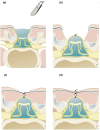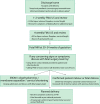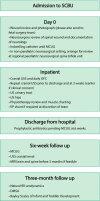Fetal surgery for open spina bifida
- PMID: 31787844
- PMCID: PMC6876677
- DOI: 10.1111/tog.12603
Fetal surgery for open spina bifida
Abstract
Key content: Spina bifida is a congenital neurological condition with lifelong physical and mental effects.Open fetal repair of the spinal lesion has been shown to improve hindbrain herniation, ventriculoperitoneal shunting, independent mobility and bladder outcomes for the child and, despite an increased risk of prematurity, does not seem to increase the risk of neurodevelopmental impairment.Open fetal surgery is associated with maternal morbidity.Surgery at our institution is offered and performed according to internationally agreed criteria and protocols.Further evidence regarding long-term outcomes, fetoscopic repair and alternative techniques is awaited.
Learning objectives: To understand the clinical effects, potential prevention and prenatal diagnosis of spina bifida.To understand the rationale and evidence supporting the benefits and risks of fetal repair of open spina bifida.To understand the criteria defining those who are likely to benefit from fetal surgery.
Ethical issues: The concept of the fetus as a patient, and issues surrounding fetal death or the need for resuscitation during fetal surgery.The associated maternal morbidity in a procedure performed solely for the benefit of the fetus/child.The financial implications of new surgical treatments.
Keywords: fetal surgery; fetoscopy; myelomeningocele; prenatal; spina bifida.
© 2019 The Authors. The Obstetrician and Gynaecologist published by John Wiley & Sons Ltd on behalf of Royal College of Obstetricians and Gynaecologists.
Figures








References
-
- Bowman RM, Mclone DG, Grant JA, Tomita T, Ito JA. Spina bifida outcome: a 25‐year prospective. Pediatr Neurosurg 2001;34:114–20. - PubMed
-
- Velde Vande S, Van Biervliet S, Van Renterghem K, Van Laecke E, Hoebeke P, Van Winckel M. Achieving fecal continence in patients with spina bifida: a descriptive cohort study. J Urol 2007;178:2640–4. - PubMed
-
- Verhoef M, Barf HA, Vroege JA, Post MW, Van Asbeck FW, Gooskens RH, et al. Sex education, relationships, and sexuality in young adults with spina bifida. Arch Phys Med Rehabil 2005;86:979–87. - PubMed
Publication types
Grants and funding
LinkOut - more resources
Full Text Sources
